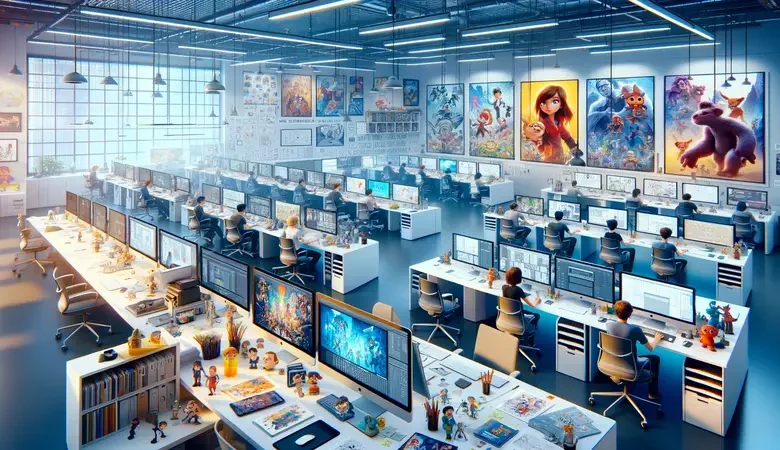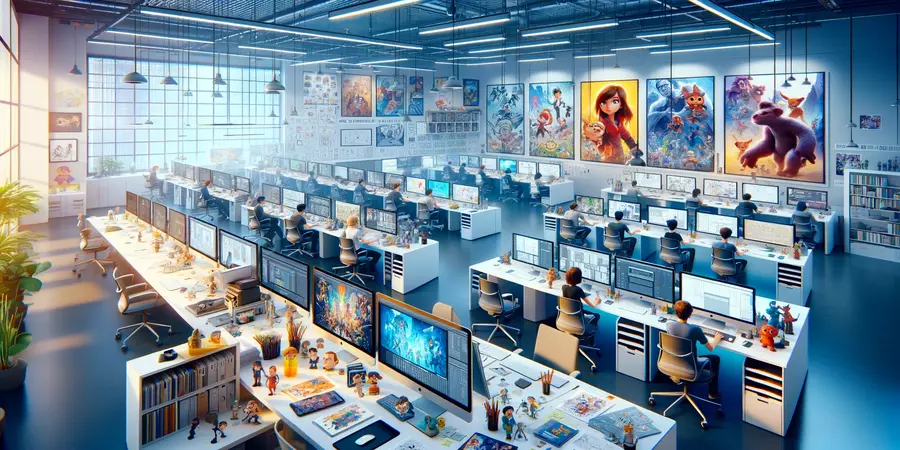
animation jobs is a fascinating and ever-evolving field that combines art, technology, and storytelling. For those with a creative flair and a passion for bringing characters, stories, and ideas to life, animation jobs offer a perfect blend of challenge and satisfaction. The vast and diverse animation industry provides opportunities across various sectors, including entertainment, gaming, advertising, and education.
This guide dives deep into the world of animation jobs, covering everything from types of roles to skills required, how to enter the industry, and tips for thriving in your career.
The World of Animation Jobs: An Overview
Animation jobs span various roles, each offering unique responsibilities and creative opportunities. Whether you are interested in 2D or 3D animation, visual effects, or motion graphics, the industry has something to suit every talent and interest.

The demand for animation jobs professionals is booming due to the growing popularity of animated films, video games, and digital advertising. Companies across the globe are constantly seeking talented animators who can bring their visions to life. This makes animation an exciting and dynamic career choice for anyone willing to hone their skills and embrace new challenges.
Additionally, animation jobs is no longer confined to traditional media. With technological advancements, animators create content for virtual reality (VR), augmented reality (AR), and other cutting-edge platforms. These innovations open new doors for aspiring professionals and established artists alike.
Types of Animation Jobs
The animation industry offers a variety of roles catering to different skill sets and interests. Here are some of the most popular types of animation jobs:
2D animation jobs
2D animation jobs create characters, environments, and storylines in a two-dimensional space. They work on projects like animated TV shows, movies, advertisements, and web content. The process typically involves drawing frame-by-frame or using software like Adobe Animate.
2D animation is ideal for those who love traditional drawing techniques and storytelling. Creating compelling visuals that resonate with audiences requires a strong understanding of movement, timing, and character design.
3D Animator
3D animators specialize in creating three-dimensional characters and environments. Using software like Blender, Maya, or Cinema 4D, they bring objects and characters to life with realistic movements and textures.
This type of animation is widely used in movies, video games, and commercials. It’s a highly technical role that demands proficiency in modeling, rigging, and rendering, alongside a solid grasp of physics and anatomy.
Visual Effects Artist
Visual effects (VFX) artists focus on creating stunning effects that enhance live-action footage or animated content. VFX artists use their creativity and technical skills to produce realistic and awe-inspiring visuals, from explosions and weather effects to magical transformations.
VFX is a critical component of modern filmmaking and gaming, making this role essential for anyone looking to work on blockbuster movies or high-budget video games.
Motion Graphics Designer
Motion graphics designers create animated graphic elements for various media, including TV shows, films, advertisements, and websites. They often work on titles, transitions, and other elements that add a dynamic touch to visual storytelling.
This role requires expertise in design principles, typography, and animation software like After Effects. Motion graphics is an excellent career path for those with a background in graphic design who want to branch into animation.
Character Designer
Character designers develop unique and memorable characters for animated projects. They sketch concepts, refine designs, and collaborate with animators to ensure the characters fit seamlessly into the story.
This role demands a strong sense of creativity, imagination, and an understanding of human and animal anatomy. It’s perfect for artists who enjoy creating vibrant personalities and engaging visual designs.
Storyboard Artist
Storyboard artists create visual representations of scripts, mapping out scenes and sequences for animated productions. Their work serves as a blueprint for the animation team, ensuring everyone is on the same page regarding the project’s direction.
Storyboarding requires a mix of artistic and storytelling skills. It’s an excellent role for those who love planning and conceptualizing stories visually.
Game Animator
Game animators work on creating animations for video games, bringing characters, environments, and objects to life. They focus on ensuring smooth, engaging, and realistic gameplay experiences.
This role involves collaboration with game developers, designers, and programmers, making it an excellent fit for those who enjoy teamwork and have a passion for gaming.
Background Artist
Background artists are responsible for designing and creating the environments in which animated stories unfold. Their work includes landscapes, interiors, and other settings that enhance the mood and tone of the project.
This role suits artists with a keen eye for detail and a love for creating immersive worlds.
Skills Required for Animation Jobs
You need a blend of technical and artistic skills to excel in animation jobs. Here are some essential skills every aspiring animator should develop:
Creativity and Imagination
Animation is all about bringing ideas to life. Whether you’re designing characters, crafting stories, or creating visual effects, a strong imagination and creative thinking are critical.
Technical Proficiency
Mastering animation software and tools is non-negotiable. Depending on your area of interest, you’ll need to become proficient in tools like Adobe Animate, Blender, Maya, After Effects, and others.
Attention to Detail
Precision is key in animation. From ensuring smooth transitions to perfecting character movements, attention to detail can make or break a project.
Storytelling Skills
An animator’s work is ultimately about storytelling. Understanding narrative structure, pacing, and character development will help you create content that captivates audiences.
Teamwork and Communication
Animation projects often involve collaboration with other artists, writers, and directors. Strong communication and teamwork skills are essential for ensuring a seamless workflow.
How to Start Your Career in Animation
Breaking into the animation industry requires dedication and preparation. Here’s how you can get started:
Education and Training
While a degree in animation or a related field isn’t always necessary, it can provide a strong foundation in the principles of animation and access to valuable resources like software and mentorship. Many animators also attend workshops, online courses, and boot camps to sharpen their skills.
Build a Strong Portfolio
Your portfolio is your ticket to landing animation jobs. Focus on showcasing your best work, including personal projects, school assignments, and freelance gigs. Highlight a variety of skills and styles to demonstrate your versatility.
Network with Industry Professionals
Networking is crucial in the animation jobs industry. Attend industry events, join online forums, and connect with professionals on platforms like LinkedIn. Building relationships can lead to job opportunities and valuable mentorships.
Gain Experience
Look for internships, freelance opportunities, or entry-level positions to gain hands-on experience. Working on real-world projects will help you refine your skills and build a network of industry contacts.
Thriving in Your Animation Career
Once you’ve landed your first animation jobs, it’s time to focus on growth and success. Here are some tips for thriving in the industry:
Keep Learning
animation jobs is a constantly evolving field. Stay updated on industry trends, new software, and emerging technologies to keep your skills relevant and in demand.
Embrace Feedback
Constructive criticism is invaluable for growth. Be open to feedback from colleagues, clients, and mentors, and use it to improve your work.
Develop a Specialization
While versatility is essential, developing expertise in a specific area—like 3D animation, VFX, or character design—can make you stand out in the job market.
Balance Creativity with Deadlines
animation jobs projects often come with tight deadlines. Learning to balance your creative process with time management is crucial for delivering high-quality work on schedule.
Build a Personal Brand
Create an online presence through social media, personal websites, or blogs. Sharing your work and insights can help you attract job offers and establish yourself as a thought leader in the industry.
Conclusion
Animation jobs offer endless opportunities for creative expression and professional growth. Whether you’re just starting or looking to advance your career, the key to success lies in honing your skills, staying adaptable, and building strong relationships within the industry. With dedication and passion, you can turn your love for animation into a fulfilling and rewarding career.